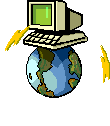ICT across the curriculum - is a key aim for all schools. The use of ICT in the classroom is not an optional extra; it SHOULD BE a National Curriculum requirement.
ICT - Information Communication Technology - is the technical term given to the use of computers in education. The 'Communication' part is a fairly recent addition to take account of the connected nature of the Internet.
As teachers, ICT can bring enormous benefits to the class. From an educational aspect, the use of computers brings dynamism to lessons, putting pupils more in control of their learning, permitting independent progress and development. If used effectively, ICT can be an incredible tool for every single subject. From the pupils' aspect, the response can be seen immediately.
 Whilst such keenness is a welcome benefit, if pupils are entering a lesson with such a positive attitude the learning potential is already increased. The interactive nature of computers allows pupils to become more involved, permitting effective and active learning
Whilst such keenness is a welcome benefit, if pupils are entering a lesson with such a positive attitude the learning potential is already increased. The interactive nature of computers allows pupils to become more involved, permitting effective and active learning
Yet it is vital to see ICT as another tool available for the teacher - it is not the answer for everything. ICT should be used in combination with more traditional teaching techniques. Similarly the chosen ICT activity is also vital - just sitting a child in front of a PC and expecting them to teach themselves is useless.
INTERACTIVITY - effective use of ICT in the classroom makes pupils feel they are in control. Not of the class, but in terms of independent learning. They can see the results of CAMI and KHANYA LTSM immediately in front of them.
SUITABILITY - see ICT as another additional tool available to you - yet an interactive and dynamic tool. With sensible use, the educational benefits are immense.
BACKUP PLAN - always have something just in case things go wrong. A paper based activity that can be given out. Problems are bound to occur if you don't plan.



















































